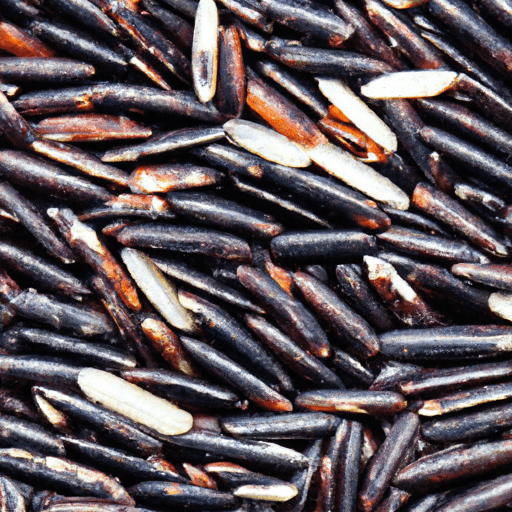Exploring the Magic of Black Rice: A Culinary Delight
Black rice, often referred to as “forbidden rice,” is a captivating and lesser-known grain that has been captivating taste buds for centuries. Not only does it offer a unique and delightful taste, but it also boasts a fascinating history and a range of potential culinary applications. In this blog post, we’ll delve into the exciting world of black rice, exploring its taste, common uses in cooking, nutritional value, and even some interesting facts and history.
The Enigmatic Taste
Black rice possesses a rich, nutty flavor that is often compared to that of brown rice. Its intriguing taste is enhanced by a subtle sweetness, giving it an edge over other grains. The texture is pleasantly chewy and lends itself well to a variety of dishes.
Incredibly Versatile in the Kitchen
While black rice may have once been reserved for royalty in ancient China, it has now found a place in kitchens worldwide. Its alluring appearance and delectable taste make it a popular addition to both sweet and savory recipes. Here are a few common ways black rice is used in cooking:
1. Entrées and Side Dishes
Black rice serves as a perfect base for a multitude of main courses and side dishes. It can be steamed and served alongside vegetables, meat, or seafood, adding both flavor and visual appeal to the plate. The striking ebony color of the rice creates a stunning contrast when plated with vibrant ingredients.
2. Salads and Bowls
Black rice brings a unique twist to salads and grain bowls, making them more visually striking and satisfying. Its hearty texture and slightly sweet taste provide a pleasant surprise in cold dishes. Pair it with colorful vegetables, fruits, or even proteins like grilled chicken or tofu, and you’ve got yourself a satisfying meal.
3. Desserts
One of the most remarkable aspects of black rice is its ability to work harmoniously in desserts. Its natural sweetness lends itself to be used in rice puddings, sweet risottos, and even sushi. Use it as a base for a delightful rice pudding topped with fresh fruits, or try your hand at creating a delectable black rice ice cream.
A Treasure Trove of Nutrition
Aside from its captivating taste and versatility, black rice is also packed with essential nutrients. This whole grain, derived from the same plant species as white rice, contains an impressive array of beneficial components. Let’s take a quick peek into the nutritional value of black rice:
Antioxidants: Black rice is rich in anthocyanin antioxidants, which give it its distinctive dark color. These antioxidants help combat harmful free radicals in the body, supporting overall health and well-being.
Fiber: Just half a cup of cooked black rice provides a significant amount of dietary fiber, helping maintain a healthy digestive system and promoting feelings of fullness.
Minerals: Black rice contains essential minerals like iron and copper, which are vital for maintaining healthy red blood cells and promoting optimal brain function.
Vitamins: This vibrant grain also boasts several essential vitamins, including vitamin E, which supports skin health, and B vitamins, which contribute to energy production.
Exploring the Mystical Origins
As we explore the intriguing history of black rice, we find that it was once considered so rare and valuable that it was exclusively consumed by Chinese emperors. It was believed that eating black rice would lead to a longer and healthier life. Today, it is cultivated in various parts of the world and has become more accessible to food enthusiasts across the globe.
In Conclusion
Whether you’re seeking an extraordinary addition to your meals or an ingredient that offers both flavor and nutrition, black rice is a true gem. Its captivating taste, versatility in cooking, and nutritional benefits make it a must-try for any food lover. So, why not embark on a culinary adventure and discover the many wonders of black rice? Your taste buds will thank you!
Black Rice
Origin: Black rice, also known as forbidden rice, originated in ancient China. It was cultivated in limited quantities and reserved for emperors or nobility due to its rarity and nutritional benefits. It is believed to have been grown for more than 10,000 years.
Common Uses: Black rice is commonly used in Asian cuisine, particularly in Chinese, Thai, and Indonesian dishes. It can be used for making rice bowls, stir-fries, sushi, desserts, and even alcoholic beverages. In Western cuisine, black rice is often used as a side dish, in salads, or as a filling for stuffed vegetables.
Nutritional Benefits: Black rice is highly nutritious and packed with antioxidants. It contains more protein, dietary fiber, and iron compared to other types of rice. It also contains anthocyanins, the same powerful antioxidants found in blueberries and blackberries. These antioxidants are known for their anti-inflammatory properties and can help protect against chronic diseases.
Unique Properties: What sets black rice apart is its striking appearance and unique flavor. When cooked, the outer layer of the grain turns dark purple or black, while the inner part becomes tender and slightly sticky. Its flavor is nutty and slightly sweet. Black rice also retains its shape well and doesn’t become mushy when cooked.
Historical Significance: In ancient China, black rice was considered a luxurious and precious food reserved for special occasions. It was believed to bring good fortune, and its consumption was associated with longevity. Over time, the cultivation and consumption of black rice spread beyond China to other parts of Asia and eventually to other parts of the world. Today, it is enjoyed by people looking for a nutritious and visually appealing alternative to white or brown rice.




Use the share button below if you liked it.
It makes me smile, when I see it.